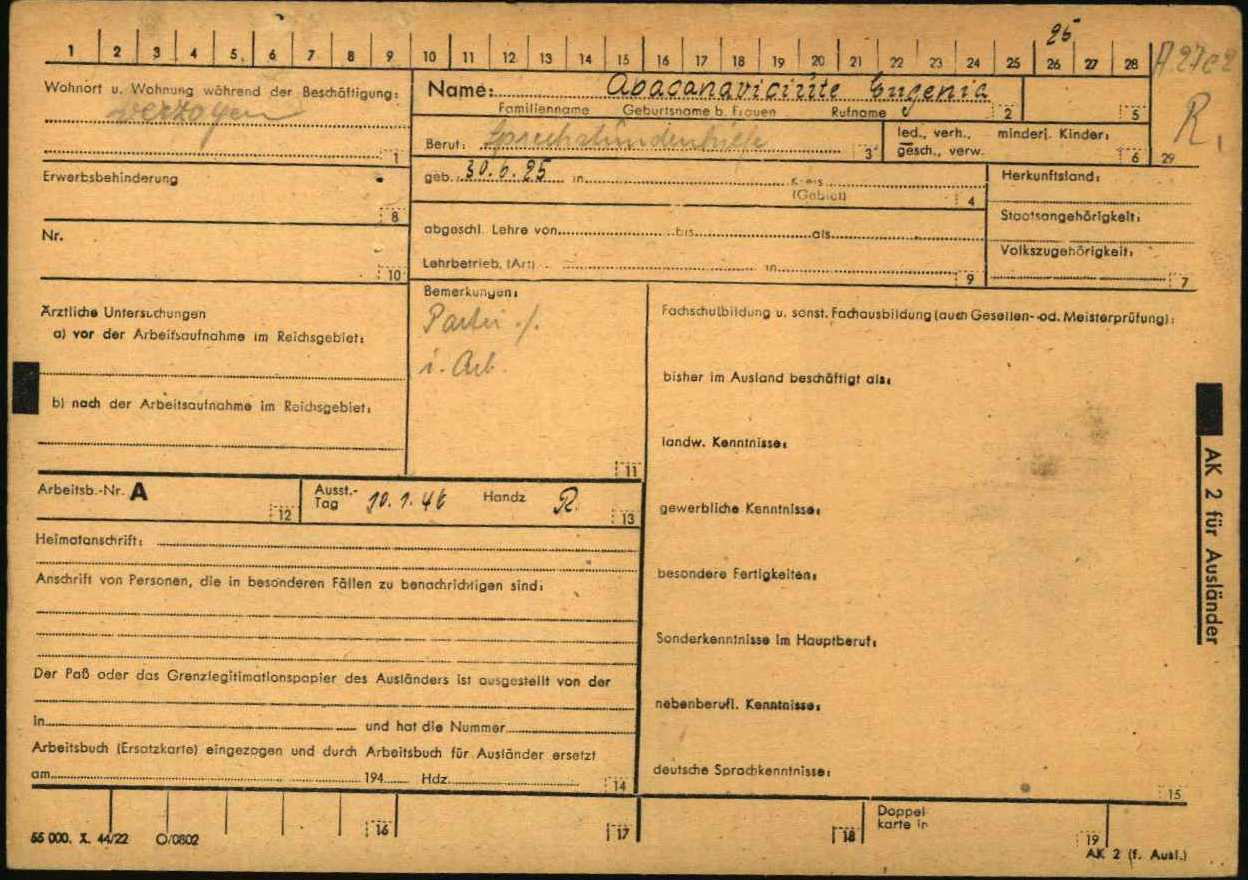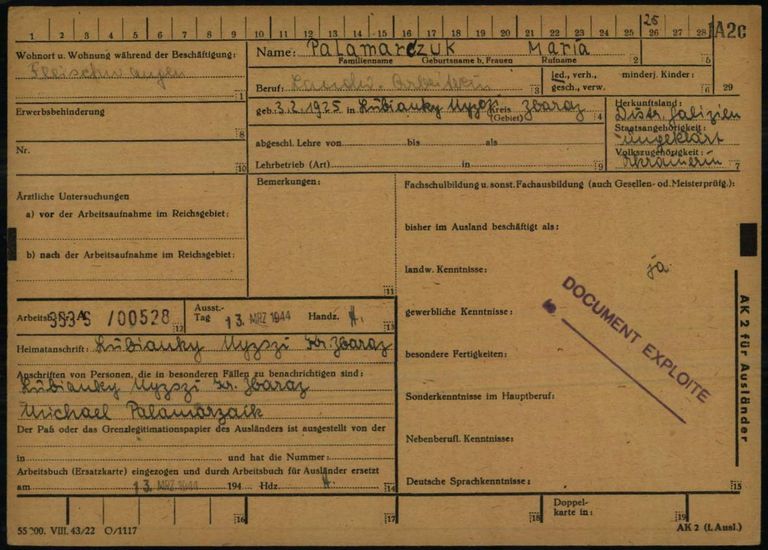Page of
Page/
- Reference
- Intro


Work book cards (Arbeitsbuchkarten) were used in employment offices to manage and coordinate labor deployment (Arbeitseinsatz). The Nazis used this term to describe the state regulation of the labor market. As well as information from work books, work book cards also contained additional information about the professional skills of the respective person. Initially, the same work book cards that were used for German workers were used for foreign workers. It was not until 1943 that separate forms were used for civilian forced laborers, like those that can be seen here.
Work book cards (Arbeitsbuchkarten) were used in employment offices to manage and coordinate labor deployment (Arbeitseinsatz). The Nazis used this term to describe the state regulation of the labor market. As well as information from work books, work book cards also contained additional information about the professional skills of the respective person. Initially, the same work book cards that were used for German workers were used for foreign workers. It was not until 1943 that separate forms were used for civilian forced laborers, like those that can be seen here.
Questions and answers
-
Where was the document used and who created it?
Employment office staff issued work book cards along with work books. They managed these cards in the offices in a work book card index and made changes when companies reported them. When there was a change of workplace, the staff forwarded cards to the relevant new employment office.
- When was the document used?
From as early as May 1935, German workers were increasingly required to keep a work book. The category of people under this obligation was gradually expanded until all German workers had to have a work book, and thus work book cards as well. From May 1941, all foreign workers were also required to keep a work book. Consequently, work book cards were created for all civilian forced laborers in addition to their work books from this point onwards. The General Plenipotentiary for Labor Deployment (GBA), Fritz Sauckel, finally introduced separate work book cards for foreigners in the “Decree on Work Books for Foreign Workers” of May 1, 1943. By the end of the Second World War, work book cards formed the basis for planning and implementing forced labor.
- What was the document used for?
The individual employment offices used work book cards to manage all the workers who were under their jurisdiction. Work book cards therefore existed for all workers regardless of their nationality; both German and foreign workers had a work book card. Even before the Second World War and the use of civilian forced laborers on a huge scale, the employment offices were able to use the cards to search for workers for the armaments industry, which was essential to the war effort.
While the work books of civilian forced laborers were returned to their employers, forced labor could be monitored by local employment offices using the work book cards. In order to do so, the work book card index always needed to be up to date. Consequently, employers had to report any changes relating to workers employed by them to the relevant employment office. Employment office staff then transferred this information to the work book cards. This is why details about a person’s occupation and place of residence are written in pencil in some cases, as these details could change.
Each employment office had its own work book card index, which in turn was divided into several separate card indexes. From 1941 onwards, these had to be organized in a standardized format in all employment offices by order of the Reich Ministry of Labor. The most important card index was the so-called main card index (Hauptkartei). It contained the work book cards of all employees in possession of a work book in alphabetical order. The work book cards of civilian forced laborers were kept separately from those relating to German workers. The cards were also sorted separately in the index according to gender. Different preprinted cards were used: for men the AK 1, i.e. work book card 1, and for women the AK 2. The color code that was actually prescribed for the main card index – men on brown cards and women on white ones – could not be maintained due to the increasing shortage of paper as the war progressed.
As well as cards from the main card index, the Arolsen Archives also received a few index cards from the so-called search index (Suchkartei). If civilian forced laborers were assigned to a new place of work and came under the jurisdiction of another employment office as a result, their work book cards were forwarded to the new employment offices. Staff at the “old” employment office then used cards for the search index marked AK 7 to note when and where they had sent the work book cards. This allowed them to keep constant track of where civilian forced laborers were deployed.
However, civilian forced laborers were not just managed in individual employment offices using work book cards. A central card index was also held at the Reich Ministry of Labor in Berlin. From 1943 onwards, staff in local employment offices were required to send copies of all work book cards relating to civilian forced laborers and any changes made to them to Berlin for this purpose. In the Reich Ministry of Labor, Department V (later renamed Department VIe) kept a central work book card index for all civilian forced laborers in the German Reich. This index does not exist anymore.
- How common is the document?
In theory, employment office staff must have created work book cards for all civilian forced laborers who were employed in the German Reich. So it is safe to assume that there must have been millions of these cards. However, many letters from the post-war period describing the loss or destruction of these documents are preserved in the Arolsen Archives. Hence, after the war, work book cards only arrived at the International Tracing Service (ITS), the predecessor institution of the Arolsen Archives, sporadically and in small quantities. As ITS staff sorted these cards alphabetically into the War Time Card File (Collection 2.2.2.1), which contains 4.2 million documents, thereby removing them from the card indexes they originally belonged to, it is unfortunately not known how many work book cards are preserved in the Arolsen Archives. But in the near future, modern computer technology will find the answer: clustering techniques will make it possible to identify work book cards, as well as other documents, and to virtually collate cards of the same type. However, by no means all the work book cards of civilian forced laborers have survived.
- What should be considered when working with the document?
Work book cards are sometimes also mistakenly referred to as labor cards. However, these cards came into being in a different context. While work book cards stayed in employment offices, civilian forced laborers carried their labor cards on their person as a means of identification.
Employment office staff were instructed by the Reich Ministry of Labor to take great care to ensure that the information they recorded was correct and complete. However, it quickly became apparent that maintaining the work book card index was very time-consuming. Staff at the employment offices were soon no longer able to keep the index cards up to date. Especially in the last few months of the war, work book cards were often only filled out in minimum detail, and eventually, existing cards were no longer updated at all.
If you have any additional information about this document, please send your feedback to eguide@arolsen-archives.org. The document descriptions in the e-Guide are updated regularly – and the best way for us to do this is by incorporating the knowledge you share with us.
Variations
Help for documents
About the scan of this document <br> Markings on scan <br> Questions and answers about the document <br> More sample cards <br> Variants of the document



